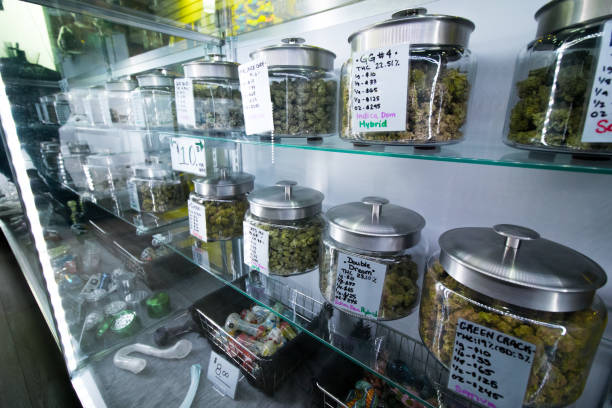Introducing the Finest Cannabis Store Calgary: Quality and Range
Wiki Article
Exploring the Therapeutic Power of Cannabis: How This Plant Provides Promising Health Conveniences for Numerous Conditions
The therapeutic potential of cannabis has garnered increasing attention within the clinical area recently. With a long history of use in various societies for medical objectives, marijuana consists of compounds referred to as cannabinoids that communicate with the body's endocannabinoid system. These interactions have revealed assurance in resolving problems ranging from chronic discomfort to psychological health and wellness conditions. By discovering the mechanisms via which marijuana exerts its effects and the emerging study on its restorative applications, a deeper understanding of this plant's health advantages can be obtained.
Background of Cannabis Usage in Medicine
The use of cannabis for medical functions dates back thousands of years, with early documents mapping its origins to old China, Egypt, and India. In ancient China, marijuana was made use of for its analgesic buildings, while in India, it was revered for its spiritual importance and healing impacts.In the 19th century, cannabis became a noticeable component in Western medicine, with doctors suggesting it for conditions ranging from pain relief to gastrointestinal issues. Regardless of this problem, recent years have seen a resurgence of interest in marijuana for its healing potential, leading to its legalisation for clinical use in many components of the world.
Cannabinoids and Their Results
Cannabinoids, the chemical compounds found in cannabis, play an important role in exerting different therapeutic results on the human body (Cannabis store Calgary). Amongst the over 100 different cannabinoids determined in cannabis, the most widely known are tetrahydrocannabinol (THC) and cannabidiol (CBD) THC is mostly in charge of the psychoactive results of cannabis, while CBD is non-intoxicating and has been linked with a range of potential wellness advantagesResearch suggests that cannabinoids interact with the body's endocannabinoid system, a complicated network of receptors associated with regulating various physiological procedures such as pain feeling, memory, mood, and cravings. By influencing this system, cannabinoids can regulate natural chemical release, reduce inflammation, and give alleviation from symptoms related to conditions like chronic pain, anxiousness, nausea, and epilepsy.
Additionally, the healing results of cannabinoids prolong beyond sign administration, revealing possible in dealing with conditions such as numerous sclerosis, post-traumatic tension condition (PTSD), and even particular types of cancer cells. As recurring researches remain to introduce the full therapeutic potential of cannabinoids, making use of cannabis-derived substances for medical purposes is getting acknowledgment and acceptance in the health care neighborhood.
Marijuana for Pain Monitoring

Among the key cannabinoids responsible for discomfort alleviation is cannabidiol (CBD) CBD connects with receptors in the endocannabinoid system, which play a crucial role in controling discomfort assumption. By minimizing inflammation and changing how pain signals are transferred, CBD can supply relief for problems such as arthritis, neuropathic pain, and migraine headaches.
Furthermore, tetrahydrocannabinol (THC), an additional prominent cannabinoid in cannabis, can additionally help take care of pain by binding to receptors in the brain and spine, changing the means discomfort is viewed. This twin activity of CBD and THC click here for more info in targeting pain paths makes marijuana a prospective option for individuals seeking all-natural solutions for discomfort administration. It is vital to consult with medical care professionals to establish the most appropriate marijuana products and dosages for specific pain problems.
Prospective Advantages for Mental Health And Wellness
Research searchings for suggest that cannabis may use potential advantages for psychological health via its interaction with the mind's natural chemical systems. Cannabinoids, the active compounds in marijuana, have actually shown pledge in taking care of symptoms connected with numerous mental health and wellness problems. Tetrahydrocannabinol (THC) and cannabidiol (CBD) are 2 well-known cannabinoids that have actually been studied for their potential restorative impacts on problems such as anxiousness, clinical depression, and post-traumatic stress disorder (PTSD)THC, known for its psychoactive properties, may aid reduce signs of stress and anxiety and clinical depression by connecting with the endocannabinoid system in the mind. On the various other hand, CBD, a non-psychoactive substance, has actually revealed antidepressant and anti-anxiety properties through its communication with serotonin receptors. In addition, Check This Out CBD has actually been explored for its prospective neuroprotective results, which can be beneficial for problems like schizophrenia and bipolar illness.

While more research is needed to totally recognize the influence of marijuana on psychological wellness, initial researches reveal encouraging outcomes that require additional exploration into the healing possibility of marijuana for treating various mental wellness problems.
Emerging Research Study on Cannabis Therapeutics
Current research studies have shed light on the evolving landscape of marijuana therapies, showcasing the growing interest and possible applications in numerous medical fields. One location of emerging research is making use of marijuana compounds, such as cannabidiol (CBD) and tetrahydrocannabinol (THC), in the treatment of persistent pain. Studies have actually shown that these substances might provide analgesic results without the threat of opioid addiction, making them an encouraging choice for discomfort monitoring.Moreover, research on the possible anti-inflammatory buildings of cannabis is gaining grip. In conditions like joint inflammation, where inflammation plays a vital role in condition progression, cannabis-based treatments might supply a novel approach to sign management. Research studies have likewise explored the usage of marijuana in neurological conditions like epilepsy, with CBD revealing guarantee in lowering seizure frequency in particular forms of the illness.
Verdict
In final thought, the therapeutic capacity of marijuana for various health and wellness problems is becoming significantly recognized. From its historical usage in medication to the emerging research study on cannabinoids and their results, cannabis shows pledge for discomfort administration and psychological wellness. As scientific understanding continues to description expand, better exploration of cannabis rehabs can lead to new therapy alternatives for patients in need.In the 19th century, marijuana came to be a popular element in Western medication, with medical professionals prescribing it for conditions ranging from pain alleviation to digestive system issues.Additionally, tetrahydrocannabinol (THC), another popular cannabinoid in marijuana, can likewise aid take care of discomfort by binding to receptors in the mind and back cable, modifying the way pain is perceived. It is important to consult with healthcare experts to identify the most appropriate marijuana products and does for private pain problems.
One location of emerging research study is the use of cannabis compounds, such as cannabidiol (CBD) and tetrahydrocannabinol (THC), in the therapy of persistent discomfort. From its historical use in medicine to the emerging study on cannabinoids and their results, marijuana reveals pledge for discomfort monitoring and mental health.
Report this wiki page